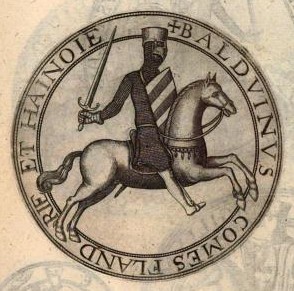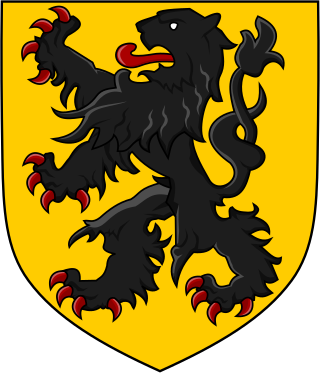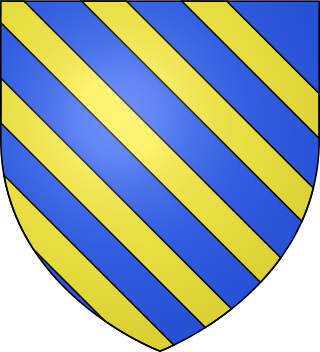
Baldwin I was the first Emperor of the Latin Empire of Constantinople; Count of Flanders from 1194 to 1205 and Count of Hainaut from 1195 to 1205. Baldwin was one of the most prominent leaders of the Fourth Crusade, which resulted in the sack of Constantinople in 1204, the conquest of large parts of the Byzantine Empire, and the foundation of the Latin Empire. The following year he was defeated at the Battle of Adrianople by Kaloyan, the emperor of Bulgaria, and spent his last days as a prisoner.

Peter, also Peter II of Courtenay, was emperor of the Latin Empire of Constantinople from 1216 to 1217.
Yolanda, often called Yolanda of Flanders, was Empress of the Latin Empire in Constantinople, first as the wife of Emperor Peter from 1216 to 1217 and thereafter as regent until her death in 1219. Peter was captured and imprisoned before he could reach Constantinople, so Yolanda assumed the duties of governing the Empire. She was ruling Marchioness of Namur from 1212 until 1217.

Margaret, often called Margaret of Constantinople, ruled as Countess of Flanders during 1244–1278 and Countess of Hainaut during 1244–1253 and 1257–1280. She was the younger daughter of Baldwin IX, Count of Flanders and Hainaut, and Marie of Champagne.

Theoderic, commonly known as Thierry of Alsace, was the fifteenth count of Flanders from 1128 to 1168. With a record of four campaigns in the Levant and Africa, he had a rare and distinguished record of commitment to crusading.

Philip I, commonly known as Philip of Alsace, was count of Flanders from 1168 to 1191. During his rule Flanders prospered economically. He took part in two crusades and died of disease in the Holy Land.
Marie of Champagne was the first Latin Empress of Constantinople by marriage to Emperor Baldwin I. She acted as regent of Flanders during the absence of her spouse from 1202 until 1204.

Baldwin V of Hainaut was count of Hainaut (1171–1195), margrave of Namur as Baldwin I (1189–1195) and count of Flanders as Baldwin VIII (1191–1195).

Theresa of Portugal was Countess of Flanders by marriage to Philip I, Count of Flanders, and Duchess of Burgundy by marriage to Odo III, Duke of Burgundy. She was the daughter of the Portuguese king Afonso I and Matilda of Savoy. She served as co-regent of Portugal with her brother during the illness of their father Afonso I of Portugal from 1172 until 1173, and regent of Flanders in 1191 during the interim period after the death of her spouse and the accession of his heir.

Ralph I of Vermandois was Count of Vermandois. He was a son of Hugh, Count of Vermandois and his wife, Adelaide, Countess of Vermandois. Ralph was a grandson of Henry I of France, while Ralph's mother had been the Carolingian heiress to Herbert IV, Count of Vermandois.
Richilde, Countess of Mons and Hainaut, was a ruling countess of Hainaut from c. 1050 until 1076, in co-regency with her husband Baldwin VI of Flanders and then her son Baldwin II of Hainaut. She was also countess of Flanders by marriage to Baldwin VI between from 1067 to 1070. She ruled Flanders as regent during the minority of her son Arnulf III in 1070–1071.

Gertrude of Saxony, also known as Gertrude Billung, was a countess of Holland by marriage to Floris I, Count of Holland, and countess of Flanders by marriage to Robert I, Count of Flanders. She was regent of Holland in 1061-1067 during the minority of her son Dirk V, and regent of Flanders during the absence of her spouse in 1086–1093.

Philip I, called the Noble, was the margrave of Namur from 1195 until his death. He was the second son of Count Baldwin V of Hainault and Countess Margaret I of Flanders. His paternal grandmother was Alice of Namur.
Hervé IV of Donzy was a French nobleman and participant in the Fifth Crusade. By marriage in 1200 to Mahaut de Courtenay (1188–1257), daughter of Peter II of Courtenay, he became Count of Nevers.

The House of Flanders, also called the Baldwins, was a medieval ruling family of Frankish origin that was founded by Baldwin Iron Arm, son-in-law of Charles the Bald. The House of Flanders was the first dynasty to transform a county function of the Carolingian Empire into a hereditary fiefdom, the County of Flanders, falling under West Francia, created by the Treaty of Verdun in 843.

The House of Dampierre played an important role during the Middle Ages. Named after Dampierre, in the Champagne region, where members first became prominent, members of the family were later Count of Flanders, Count of Nevers, Counts and Dukes of Rethel, Count of Artois and Count of Franche-Comté.
Margaret, Marchioness of Namur was ruling Marchioness of Namur, from 1229 to 1237. She was the daughter of Peter of Courtenay, Latin Emperor of Constantinople (1216-1219) and Yolanda of Flanders. By marriage to Henry I, Count of Vianden, she was Countess-consort of Vianden.

Elisabeth, also known as Isabelle Mabille, was ruling Countess of Vermandois from 1168 to 1183, and also Countess of Flanders by marriage to Philip I, Count of Flanders. She was the eldest daughter of Ralph I, Count of Vermandois and his second spouse, Petronilla of Aquitaine.

William II, Lord of Béthune, nicknamed William the Red was French nobleman. He was a ruling Lord of Béthune, Richebourg and Warneton, as well as hereditary advocatus of the Abbey of St. Vaast, near Arras.
Hugh IV of Saint-Pol from the House of Campdavaine, son of Anselm of Saint-Pol, was count of Saint-Pol from 1174 to his death, and lord of Demotika (Didymoteicho) in Thrace in 1204–05. He participated in the Third and Fourth Crusades.














